- Home
- About
- Map
- Trips
- Bringing Boat West
- Migration West
- Solo Motorcycle Ride
- Final Family XC Trip
- Colorado Rockies
- Graduates' XC Trip
- Yosemite & Nevada
- Colorado & Utah
- Best of Utah
- Southern Loop
- Pacific Northwest
- Northern Loop
- Los Angeles to NYC
- East Coast Trips
- 1 Week in Quebec
- Southeast Coast
- NH Backpacking
- Martha's Vineyard
- Canadian Maritimes
- Ocracoke Island
- Edisto Island
- First Landing '02
- Hunting Island '02
- Stowe in Winter
- Hunting Island '01
- Lake Placid
- Chesapeake
- Provincetown
- Hunting Island '00
- Acadia in Winter
- Boston Suburbs
- Niagara Falls
- First Landing '99
- Cape Hatteras
- West Coast Trips
- Utah Off-Roading
- Maui
- Mojave 4WD Course
- Colorado River Rafting
- Bishop & Death Valley
- Kauai
- Yosemite Fall
- Utah Off-Road
- Lost Coast
- Yosemite Valley
- Arizona and New Mexico
- Pescadero & Capitola
- Bishop & Death Valley
- San Diego, Anza Borrego, Joshua Tree
- Carmel
- Death Valley in Fall
- Yosemite in the Fall
- Pacific Northwest
- Utah Off-Roading
- Southern CA Deserts
- Yosemite & Covid
- Lake Powell Covid
- Eastern Sierra & Covid
- Bishop & Death Valley
- Central & SE Oregon
- Mojave Road
- Eastern Sierra
- Trinity Alps
- Tuolumne Meadows
- Lake Powell Boating
- Eastern Sierra
- Yosemite Winter
- Hawaii
- 4WD Eastern Sierra
- 4WD Death Valley +
- Southern CA Deserts
- Christmas in Tahoe
- Yosemite & Pinnacles
- Totality
- Yosemite & Sierra
- Yosemite Christmas
- Yosemite, San Diego
- Yosemite & North CA
- Seattle to Sierra
- Southwest Deserts
- Yosemite & Sierra
- Pacific Northwest
- Yosemite & South CA
- Pacific Northwest
- Northern California
- Southern Alaska
- Vancouver Island
- International Trips
- Index
- Tips
- Books
- Photos/Videos
- Search
- Contact
Peak to Peak Highway
Friday, July 22, 2011 - 7:15am by Lolo85 miles and 2.5 hours from our last stop
Travelogue
 Determined Pine TreeToday our objective was to all converge at Marys Lake Campground in Estes Park, right outside the eastern entrance to Rocky Mountain National Park, where I had reserved a campsite for two nights. Tommy and Andrew had to go back to Boulder to pick up John, Tommy’s friend who would be joining us for the weekend, and they would head up together in the evening. Herb and I would take the more scenic Peak to Peak Highway up to Estes Park.
Determined Pine TreeToday our objective was to all converge at Marys Lake Campground in Estes Park, right outside the eastern entrance to Rocky Mountain National Park, where I had reserved a campsite for two nights. Tommy and Andrew had to go back to Boulder to pick up John, Tommy’s friend who would be joining us for the weekend, and they would head up together in the evening. Herb and I would take the more scenic Peak to Peak Highway up to Estes Park.
Since Tommy didn’t have to be in Boulder until John finished work, we thought we would try to do something together before taking our different paths to Estes Park. We all thought a run would do us some good, so Tommy, who had spent the summer training on the trails around Boulder, suggested the Betasso Preserve in Boulder. Going back to Boulder was a bit out of the way for me and Herb, but we felt it would be worth the extra miles. Maneuvering and parking an RV in Boulder is not necessarily an easy thing. Fortunately, I had called the Chamber of Commerce while planning the trip and found that the best place to park an RV would be at the Target at 2800 Pearl Street (28th + Pearl).
After depositing the RV at Target, we jumped in Tommy’s car and headed back out of town to the Betasso Preserve. We retraced our steps on Boulder Canyon Drive (Highway 119) for about 6 miles before Tommy turned onto Sugarloaf Road and drove up to the Preserve, which overlooked the town of Boulder. I must say I was pretty impressed with Tommy’s local knowledge of the area. We would never have known that this beautiful place existed. While mostly a mountain biker’s heaven, the trails in the preserve were also great for running.
 Picnic lunch at Betasso PreserveWe chose to run the popular 3.2-mile Canyon Loop Trail which leads through a lovely pine and fir forest and grassy meadows. Also, by Boulder standards, it was considered relatively flat. Since we are usually accustomed to running 5 to 10 miles, I figured we would do the loop twice. Once again, I was humbled by the high altitude. The boys took off at a much brisker pace than Herb and I could emulate for more than 10 feet and soon disappeared from view in the forest, while Herb and I plodded along at a more reasonable and enjoyable pace. I felt pretty good at first, but then the legs got heavier and the slight headache returned. This was my third full day at high altitude, which apparently wasn’t enough. I began to do what the boys refer to as “Eatin’ it.” Herb seemed to be faring much better. Perhaps, his additional days out West before my arrival had given him an altitude adjustment advantage. I finally succumbed to what I hate to do on a run – walk. I just couldn’t run anymore. The sun was beating down on me and my legs felt like lead. Tommy, who had been out in Colorado for 6 weeks already, was the only one of us that took that second loop. Andrew and I looked like we had just run a marathon.
Picnic lunch at Betasso PreserveWe chose to run the popular 3.2-mile Canyon Loop Trail which leads through a lovely pine and fir forest and grassy meadows. Also, by Boulder standards, it was considered relatively flat. Since we are usually accustomed to running 5 to 10 miles, I figured we would do the loop twice. Once again, I was humbled by the high altitude. The boys took off at a much brisker pace than Herb and I could emulate for more than 10 feet and soon disappeared from view in the forest, while Herb and I plodded along at a more reasonable and enjoyable pace. I felt pretty good at first, but then the legs got heavier and the slight headache returned. This was my third full day at high altitude, which apparently wasn’t enough. I began to do what the boys refer to as “Eatin’ it.” Herb seemed to be faring much better. Perhaps, his additional days out West before my arrival had given him an altitude adjustment advantage. I finally succumbed to what I hate to do on a run – walk. I just couldn’t run anymore. The sun was beating down on me and my legs felt like lead. Tommy, who had been out in Colorado for 6 weeks already, was the only one of us that took that second loop. Andrew and I looked like we had just run a marathon.
We had a nice picnic lunch on a table overlooking a nice view of Boulder. I can understand why outdoor enthusiasts flock to this area. Plus, training at this area must make you feel like superman when you get back to sea level. Before separating from the boys for our drive up to Estes Park, we stopped at Tommy’s favorite store: REI, which sold every conceivable toy to be used in the outdoors. It was a very tempting experience.
 Herb and Tom after running Canyon Loop TrailWe said goodbye to the boys for now and headed back out on Boulder Creek Canyon road towards Nederland where we would meet up with the Peak to Peak Scenic Highway, this time heading north on Route 72 and eventually Route 7 towards Estes Park.
Herb and Tom after running Canyon Loop TrailWe said goodbye to the boys for now and headed back out on Boulder Creek Canyon road towards Nederland where we would meet up with the Peak to Peak Scenic Highway, this time heading north on Route 72 and eventually Route 7 towards Estes Park.
Since it was just the two of us, we decided to spend the day doing something we like to do, but which the boys have not yet developed the same level of enthusiasm for – geocaching. For a full explanation on what geocaching is, see the description in our last stop or check out www.geocaching.com. Real briefly, geocaching is kind of like treasure hunting or orienteering. It involves using a GPS and a series of hints to search for hidden containers (ranging from tiny micro-size ones to large ammo boxes) that have been hidden by fellow geocachers. Some geocaches have little “treasures” in them (mostly little junky trinkets that you would normally throw out), but the real attraction is the journey towards finding them. There are over a million of them hidden throughout the world, and the people hiding them are usually locals that know about interesting places to visit that you would never come across otherwise. We think it’s fun. The boys think it’s embarrassing.
We “bagged” six of them along the way—a fairly productive day—and in the process discovered a lovely swimming beach along Boulder Creek, a great view of the Barker Reservoir Dam, and several awesome views of babbling brooks and snow-capped peaks. We were so absorbed that we didn’t realize the time until the boys called us from Estes Park wondering where we were. They were hoping to find us all settled in with dinner cooking. No wonder they hate geocaching. It makes us such neglectful parents.
Description
The Peak to Peak highway (Colorado Highways 119, 72, and 7) is a 55-mile scenic drive with spectacular snow-capped mountain vistas of the Continental Divide. Going from south to north, the drive begins in Central City and passes through Blackhawk, Nederland, the old mining towns of Ward and Allenspark, and Meeker Park, before arriving at Estes Park near the eastern gateway to Rocky Mountain National Park. Map: Map: http://www.byways.org/explore/byways/2114/travel.html
Although there are quicker routes to Estes Park from the Denver area, this is by far the most scenic. Peak to Peak Magazine's calls it “one of the most beautiful mountain roads in the country."
Golden Gate Canyon State Park
Wednesday, July 20, 2011 - 2:45pm by Lolo82 miles and 3 hours from our last stop - 2 night stay
Travelogue
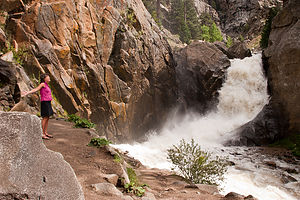 Lolo enjoying Boulder Falls mistBefore heading out to Golden Gate Canyon, we stopped briefly at Tommy’s office to meet his coworkers and boss and to collect Andrew, who had decided to spend the night at Tommy’s apartment in Boulder instead of sleeping in the Walmart parking lot with us – I can’t understand why.
Lolo enjoying Boulder Falls mistBefore heading out to Golden Gate Canyon, we stopped briefly at Tommy’s office to meet his coworkers and boss and to collect Andrew, who had decided to spend the night at Tommy’s apartment in Boulder instead of sleeping in the Walmart parking lot with us – I can’t understand why.
Tommy had managed to get the following two days off to spend with us by adding an extra two days onto the end of his internship. Today (Wednesday), however, he was going to participate in his office’s team-building day before driving out to Golden Gate Canyon to meet us that evening. The teambuilding event was going to culminate in a 3-person team go-kart race that evening. Rumor had it that it got pretty intense, so he absolutely didn’t want to miss it.
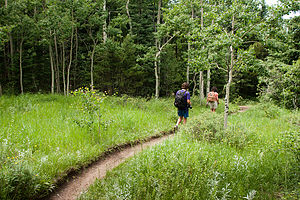 Hiking the Raccoon Loop TrailHerb, Andrew, and I set out on Boulder Creek Canyon Drive (Highway 119), which wound through Boulder Canyon along Boulder Creek. It was a beautiful drive, and I was intrigued by the walking/biking trail that ran along the creek for a good part of the drive. Boulder is a town known for its outdoor enthusiasts, and it appeared that many of them were out on that trail biking, walking, running, and just in general enjoying the beautiful scenery. The creek also looked like a fun place for tubing and kayaking, but this year it was still too high and fast to safely do that.
Hiking the Raccoon Loop TrailHerb, Andrew, and I set out on Boulder Creek Canyon Drive (Highway 119), which wound through Boulder Canyon along Boulder Creek. It was a beautiful drive, and I was intrigued by the walking/biking trail that ran along the creek for a good part of the drive. Boulder is a town known for its outdoor enthusiasts, and it appeared that many of them were out on that trail biking, walking, running, and just in general enjoying the beautiful scenery. The creek also looked like a fun place for tubing and kayaking, but this year it was still too high and fast to safely do that.
About 11 miles into the drive, we made a brief stop at Boulder Falls where North Boulder Creek plunges into Middle Boulder Creek. There is a short trail that leads to a viewpoint just below the 70-foot cascade. Continuing on, we came to a large reservoir near the town of Nederland before the road turned south toward Golden Gate.
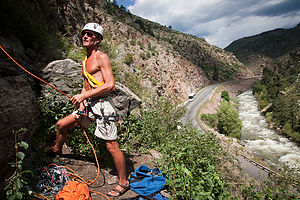 Dad belaying Tom at Clear Creek Canyon - AJGAlong the drive I kept anxiously looking at my cell phone to see if and where I got any coverage. It’s funny how we have become so dependent on constant access to the outside world. For years we traveled without cell phones and it never bothered me. Now, I go into a panic anytime those little bars disappear. My major concern was the ability to reach my 91-year-old mother, who although is in an assisted living facility, is very dependent on hearing from me about 20 times a day. I took note of the fact that I had coverage just a few miles south of Nederland, but then lost it from that point on all the way to our campground in the park. So, we turned around and drove back towards Nederland so I could call my mom and warn her that we might be out of touch for a few days.
Dad belaying Tom at Clear Creek Canyon - AJGAlong the drive I kept anxiously looking at my cell phone to see if and where I got any coverage. It’s funny how we have become so dependent on constant access to the outside world. For years we traveled without cell phones and it never bothered me. Now, I go into a panic anytime those little bars disappear. My major concern was the ability to reach my 91-year-old mother, who although is in an assisted living facility, is very dependent on hearing from me about 20 times a day. I took note of the fact that I had coverage just a few miles south of Nederland, but then lost it from that point on all the way to our campground in the park. So, we turned around and drove back towards Nederland so I could call my mom and warn her that we might be out of touch for a few days.
We arrived at the Reverend Ridge Campground on Gap Road in the northwestern corner of the park, where I had reserved a site for two nights. A lightning strike the day before had taken out the campground water supply, but fortunately we had a full tank and could shower in the RV.
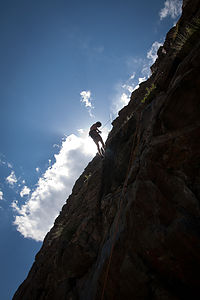 Tom descending Clear Creek Canyon climb - AJGFor the afternoon, I had selected what I thought would be the fairly easy 3.3-mile Raccoon Loop Trail. What I forgot to consider was that we had been at 200’ above sea level just yesterday morning and were now at 9100’. We are in pretty good shape—especially Andrew, so we couldn’t believe how big an effect the altitude had on us. We all had this annoying little headache and felt like we were dragging ourselves along the trail. I guess the good part was that the hike took up a greater part of our afternoon than planned. It was a lovely hike. It started at the campground and wound its way through beautiful aspen groves and wildflower meadows, across babbling brooks, and eventually to the highlight, Panorama Point, where we were rewarded with sweeping views of the Continental Divide.
Tom descending Clear Creek Canyon climb - AJGFor the afternoon, I had selected what I thought would be the fairly easy 3.3-mile Raccoon Loop Trail. What I forgot to consider was that we had been at 200’ above sea level just yesterday morning and were now at 9100’. We are in pretty good shape—especially Andrew, so we couldn’t believe how big an effect the altitude had on us. We all had this annoying little headache and felt like we were dragging ourselves along the trail. I guess the good part was that the hike took up a greater part of our afternoon than planned. It was a lovely hike. It started at the campground and wound its way through beautiful aspen groves and wildflower meadows, across babbling brooks, and eventually to the highlight, Panorama Point, where we were rewarded with sweeping views of the Continental Divide.
Back at the campground, we relaxed in our forested site and awaited the arrival of Tommy after his tough day of teambuilding at the go-kart track. He arrived triumphant, having been part of the 3-person winning team.
The next day, Tommy was our planner and guide. During his summer in Boulder, his interest in rock climbing had really taken off, and he had gained a lot of local knowledge as to where to go. Herb had been an avid climber for 10 years before the boys were born, and was having a great time getting back into it as the boys took an interest in it as well. This part of Colorado has so many east-west canyon roads that wind along creeks surrounded by rock walls perfect for climbing—Boulder Creek Canyon, Coal Creek Canyon, Golden Gate Canyon, and Clear Creek Canyon, just to name a few. Clear Creek Canyon near Golden was our destination for the day. Since we could use Tommy’s car and leave the RV behind, we were able to drive the steep and windy, non-RV friendly, Mountain Base Road through Golden Gate Canyon State Park down to Golden Gate Canyon Road into Golden and then back out on Clear Creek Canyon Road. This place is really incredible.
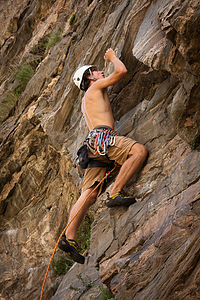 Tom leading Clear Creek Canyon 5.10 - AJGThe type of climbing that Tommy likes to do is called sport climbing. What that means is that rather than the traditional way of putting protection pieces in the rock as you climb to prevent you from falling, the bolts and protection are already permanently fixed to the rock. It’s a bit safer and quicker to set up a climb. Because of his newly found local knowledge, Tommy knew exactly where along Clear Creek Canyon to find the sport climbing wall, so it wasn’t long before we were settled at the base of a rock cliff and he was scampering up a 5.10 climb on the wall. Herb really enjoyed his first exposure to sport climbing as well. I enjoyed safely reading my Kindle on the solid ground below.
Tom leading Clear Creek Canyon 5.10 - AJGThe type of climbing that Tommy likes to do is called sport climbing. What that means is that rather than the traditional way of putting protection pieces in the rock as you climb to prevent you from falling, the bolts and protection are already permanently fixed to the rock. It’s a bit safer and quicker to set up a climb. Because of his newly found local knowledge, Tommy knew exactly where along Clear Creek Canyon to find the sport climbing wall, so it wasn’t long before we were settled at the base of a rock cliff and he was scampering up a 5.10 climb on the wall. Herb really enjoyed his first exposure to sport climbing as well. I enjoyed safely reading my Kindle on the solid ground below.
After the boys had their fill of climbing, we drove into Golden in search of the Coors Brewery—not too hard to find as it takes up most of the town. It is the largest single brewery facility in the world. We parked our car and got on line for the shuttle bus which would take us the few blocks to the brewery. After we were already in line, I noticed a sign that said that IDs were required to partake in the free sampling at the end of the tour. I panicked because I had left my wallet in the car, but Herb rightly assured me that (unfortunately) no one was going to question the fact that I was over 21.
The tour was pretty cool—self-guiding so you could take as long as you wanted to get to the end goal: the free sampling room. At one point in the tour, they handed out a little Dixie cup size sample of beer. We had heard that there were three free samples, so all we were expecting at the end were two more Dixie cups of beer, but to our surprise—and delight—the free samples included 3 full-size beers per person—quite a bit for those sea-level types not used to the high altitude. Since Tommy was only 19 and couldn’t partake in anything but free soda, he was immediately appointed our designated driver. Not being a particularly big fan of Coors beer before, I was pleased to find two beers that I really enjoyed: Killian’s Irish Red and Blue Moon.
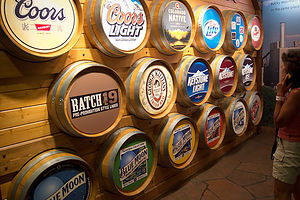 Mom on Coors Brewery Tour - TJGI’m actually pretty surprised they give away this much free beer, but I think I might have figured out why. At the beginning of the tour, they took a picture of each family in front of a green screen. When you got to the end of the tour and the end of your three beers (and sobriety), they showed you the picture of your lovely family (made lovelier by the beers) in front of a variety of backgrounds. For a mere $15, we bought the one where we were lined up in front of a stack of kegs. It just goes to show you that there is no such thing as a free beer. Proudly carrying what we thought at the time might become our family Christmas card photo, we stumbled out into the bright sunlight and walked the streets of Golden for a bit before driving back to our campground in Golden Gate Canyon.
Mom on Coors Brewery Tour - TJGI’m actually pretty surprised they give away this much free beer, but I think I might have figured out why. At the beginning of the tour, they took a picture of each family in front of a green screen. When you got to the end of the tour and the end of your three beers (and sobriety), they showed you the picture of your lovely family (made lovelier by the beers) in front of a variety of backgrounds. For a mere $15, we bought the one where we were lined up in front of a stack of kegs. It just goes to show you that there is no such thing as a free beer. Proudly carrying what we thought at the time might become our family Christmas card photo, we stumbled out into the bright sunlight and walked the streets of Golden for a bit before driving back to our campground in Golden Gate Canyon.
Back at the campground, Herb and I decided to do some geocaching while the Tommy went for a run. Andrew had to make the tough call of running with Tommy or geocaching with us. He must have really been hurting from the high altitude, because he chose to come with us on an activity that he still thinks is pretty silly.
For those of you fellow travelers unfamiliar with geocaching, I seriously recommend learning more about it (see www.geocaching.com). It can be a life-changing event. No seriously, it is a very interesting concept that has brought us to some very interesting and out-of-the way places. Very briefly, geocaching is kind of a treasure hunt, sans the treasures. Geocaches are waterproof containers (ranging from tiny little containers to ammo boxes) that contain little trinkets for trading—items that you would just throw away if you found them in your house, but for some reason feel like treasures after having gone through so much trouble trying to find them. There are over a million geocaches hidden in over 100 countries throughout the world. People searching for them use a GPS to guide them to usually within 30 feet of the hidden cache. From there, clues help the seeker zero in on the find. I know it sounds a bit silly, but it is actually a lot of fun and has exposed us to a lot of great places that we would never have found on our own.
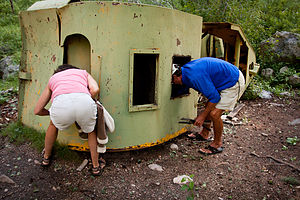 Parents geocaching - AJGThe clue this time was “green machine” and our GPS led us a short distance back down Mountain Base Road to a beautiful meadow overlooking the town of Black Hawk in the distance. See, already geocaching had brought us to a beautiful spot that we would not have discovered otherwise. We followed our GPS pointer part way down the hill and into the woods where we soon came across the wreck of an old green steamroller. I think we had found our “green machine.” Now the hard part began – finding a tiny 35mm film canister hidden somewhere within it. Andrew was truly amused by two grown adults, who he had known and respected his entire life, determinedly poking their heads, and sometimes entire bodies, into a rusty old wreck to find a hidden “treasure.” He even recorded it on his camera for posterity. He must have been so proud of me when I eventually cried out, “Found it!”
Parents geocaching - AJGThe clue this time was “green machine” and our GPS led us a short distance back down Mountain Base Road to a beautiful meadow overlooking the town of Black Hawk in the distance. See, already geocaching had brought us to a beautiful spot that we would not have discovered otherwise. We followed our GPS pointer part way down the hill and into the woods where we soon came across the wreck of an old green steamroller. I think we had found our “green machine.” Now the hard part began – finding a tiny 35mm film canister hidden somewhere within it. Andrew was truly amused by two grown adults, who he had known and respected his entire life, determinedly poking their heads, and sometimes entire bodies, into a rusty old wreck to find a hidden “treasure.” He even recorded it on his camera for posterity. He must have been so proud of me when I eventually cried out, “Found it!”
Description
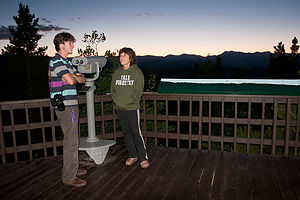 Lolo and Tom at Panorama PointGolden Gate Canyon State Park, located on the Front Range 30 miles west of Denver and 13 miles northwest of Golden , contains 12,000 acres of unspoiled landscape – rugged canyons, wildflower meadows, lodgepole forests, lush aspen groves, and meandering streams.
Lolo and Tom at Panorama PointGolden Gate Canyon State Park, located on the Front Range 30 miles west of Denver and 13 miles northwest of Golden , contains 12,000 acres of unspoiled landscape – rugged canyons, wildflower meadows, lodgepole forests, lush aspen groves, and meandering streams.
The Park contains 36 miles of hiking trails, 22 miles of which are also open to mountain biking and horseback riding. As the average elevation of the park is 9100 feet, hiking can be a challenge for those unaccustomed to the altitude. A major attraction is Panorama Point Scenic Overlook, where visitors can see 100 miles of the Continental Divide.
There are several camping options:
- Reverend’s Ridge campground, just off Gap Road, has 97 tent and RV sites, 57 of which have electrical hookups.
- Aspen Meadows Campground has 35 sites for tents only.
- Backcountry Camping - there are four backcountry three-sided shelters which can sleep up to 6 people without a tent
- In addition to the four shelters, there are 20 backcountry tent sites open year-round . Many of these sites are located in large, scenic meadows and are surrounded by 10,000 foot peaks. Backcountry camping permits must be obtained at the Visitors Center.
- 5 cabins and 2 yurts, each of which accommodate 6 people
Side trips from Golden Gate Canyon:
- Clear Creek Canyon is located along Clear Creek, just west of Golden. It is reached by taking US 6 West from the center of Golden. Besides being a beautiful drive, the walls of the canyon provide a playground for rock climbers. The following website provides details on the climbing routes available throughout the canyon : http://www.mountainproject.com/v/clear-creek-canyon/105744243
- Golden is located 15 miles west of Denver, along Clear Creek Canyon at the foothills of the Front Range of the Rocky Mountains. The town was founded during the Pike’s Peak gold Rush in 1859 and served as the capital of the Territory of Colorado from 1862 to 1867. Its population is approximately 17,000. Today Golden is best known for its being home to the Colorado school of Mines and the Coors Brewing Company. Free 30-minute, self-guided tours of the brewery are conducted throughout the day. At the end of the tour, free samples of the various beers produced are provided.
Boulder
Tuesday, July 19, 2011 - 12:30pm by Lolo115 miles and 2.5 hours from our last stop - 1 night stay
Travelogue
Andrew and I rose at the crack of dawn to catch our 7:00 am flight to Denver. I rarely fly, so I must admit to some anxiety and excitement – mostly excitement though. The flight was uneventable, and Andrew and I enjoyed a leisurely lunch in a TGIF in the Fort Worth/Dallas airport while waiting for our connection to Denver. It was so nice spending time together, just the two of us, and it was kind of cool that he was the more experienced air traveler guiding me through space rather than the reverse role that I had played with him for the previous 22 years.
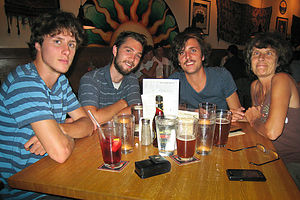 Dining at Mountain Sun BreweryHerb was anxiously awaiting our arrival in Denver. While we were en route, he situated the RV in a Walmart parking lot in Broomfield, nearby to where Tommy was working that summer. Tommy dropped his car off with Herb on his lunch break, so that Herb wouldn’t have to maneuver through a busy airport with the RV to pick me and Andrew up.
Dining at Mountain Sun BreweryHerb was anxiously awaiting our arrival in Denver. While we were en route, he situated the RV in a Walmart parking lot in Broomfield, nearby to where Tommy was working that summer. Tommy dropped his car off with Herb on his lunch break, so that Herb wouldn’t have to maneuver through a busy airport with the RV to pick me and Andrew up.
When Andrew and I got to the baggage area, we spotted Herb, who seemed really, really happy to see us. I guess life on the road alone isn’t quite as much fun as sharing it with those you love. He definitely looked ready for some company and family time. It was all coming together as planned. I couldn’t believe that that night the four of us would be all together having dinner in Boulder. The way the schedules were that summer, the boys were never home at the same time, so we had to enjoy them sequentially. The next few days were it for us, and I think we were all pretty enthused about spending some time together, something that we used to take so for granted.
At 5:00, we picked Tommy up from work. I was so happy to see him. It had been about 6 weeks since he left home for his internship in Boulder – the longest that we have ever been apart. I tried to control my enthusiasm so as not to embarrass him in front of his co-worker who was hitching a ride home to Boulder with us. I would have to save the hugs for later. Tommy’s little Subaru got even cozier when we picked up his roommate John along the way.
After dropping off Charlie the co-worker, we went to Tommy and John’s apartment right near the University of Colorado. It was a bit messy—and I am being kind, but I held my tongue. I didn’t fly all the way out here to be a nag. That’s my home job.
Tommy had done some asking around at work for dinner recommendations and was told that the Mountain Sun Brewery would give us the “quintessential Boulder experience”. I was hoping that I would get my second wind, because we had been up since 4:00 in the morning and it was already 10:00 pm eastern time. I had so been looking forward to this evening that I wasn’t going to let a little sleep deprivation get in the way.
The Mountain Sun Brewery was located near the Pearl Street Mall, a really cool 4-block, pedestrian-only area that is filled with shops, restaurants, bars, street entertainers, and lots of college-age kids – I was beginning to feel old and wrinkly. We probably could have walked from the apartment, but instead we drove closer to the Pearl Street Mall, just in case it started raining again. Their apartment was located right in the heart of the Boulder action. They must have had a blast this summer.
Despite our 8:00 reservation, the Mountain Sun Brewery was so crowded and overflowing with happy people having a good time that they weren’t ready to seat us yet. Other nearby places weren’t half as full, so we knew that Tommy must have made the right choice. This was definitely the place to be.
After much apologizing for the wait, we were finally seated. The food and service were great and sampling the different beers was great fun – for three of us anyway. Tommy and John were still 19, so for them it was probably a pretty boring spectator sport. We had so much fun that night. I caught myself several times just grinning from ear to ear as I looked around the table at Herb and the boys (and Tommy’s friend John too). People must have thought I was hitting the samplers a bit too hard, but I swear it was just the company that was making me so happy.
Description
Boulder is located 30 miles northwest of Denver, at the foot of the Flatirons of the Rocky Mountains. It has a population of 97,000, and is home to the University of Colorado. While, like many cities in Colorado, it began as a mining town, it has today become a center for scientific and environmental research and high-tech companies.
The town is an outdoor enthusiast’s dream with over 40,000 acres of open space within the city limits, 56 parks, and 200 miles of trails. Biking, running, hiking, fishing, and rock climbing are some of the favorite activities in the area. In surveys of best places to live, Boulder achieves top rankings in health, well-being, quality of life, education, and art.
Just a few of Boulder’s attractions include:
- Pearl Street Mall – a four-block pedestrian-only mall in the historic downtown district with street entertainers, restaurants, and shops
- Boulder Creek Path – a 16-mile walking/biking trail through the city and west into the Boulder Creek Canyon
- National Center for Atmospheric Research – pink-sandstone building located atop Table Mesa in the southwestern foothills of Boulder where scientists study weather, climate change, ozone depletion, etc. On display are weather balloons, satellites, and supercomputers that simulate the world’s climate. Free admission.
- University of Colorado – CU and its 29,000 students pretty much dominate the city. Its cultural and sports events have helped make Boulder what it is today.
- Eldorado Canyon State Park – 850-foot canyon located 5 miles southwest of Boulder. It is popular for mountain biking, hiking, and rock climbing.
Boyd Lake State Park
Monday, July 18, 2011 - 12:30pm by Herb242 miles and 5 hours from our last stop - 1 night stay
Travelogue
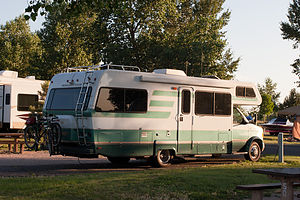 Boyd Lake campingBoyd Lake was a park that Lolo selected that would put me close to Boulder for the next day’s car transfer with Tommy, and the subsequent pickup of Lorry and Andrew from the Denver airport. This was my last night as a solo traveler! The 1,900 miles that I had come made it seem like a lot more than 4 nights from NJ, and I was looking forward to a complete reunion with my family.
Boyd Lake campingBoyd Lake was a park that Lolo selected that would put me close to Boulder for the next day’s car transfer with Tommy, and the subsequent pickup of Lorry and Andrew from the Denver airport. This was my last night as a solo traveler! The 1,900 miles that I had come made it seem like a lot more than 4 nights from NJ, and I was looking forward to a complete reunion with my family.
The park was somewhat crowded, and lake access was limited, but for one night I could tough it out. I downloaded the coordinates of the nearest geocaches into the Droid and took off on the mountain bike to get a sense of the park.
The park has miles of nice paved and unpaved biking/jogging paths. Using the bike gave me the ability to easily cover lots of ground, and also find a few geocaches on route.
The next morning, in anticipation of additional family members, I cleaned up the RV, topped off the water tanks, dumped the holding tanks, and plotted a course to the Broomfield Walmart, where I would meet Tommy for the first time in 7 weeks (our longest separation ever). Using his Subaru, I would then pick up Lolo and Andrew from Denver International Airport.
Description
Boyd Lake State Park, located just one mile east of downtown Loveland in northern Colorado, is home to one of the largest lakes in the northern Front Range. It lies at the western-most edge of the plains at the foot of the snow-capped Rockies.
The 1,700 acre (at full capacity) lake is popular for boating, water skiing, fishing, windsurfing, swimming hiking, and biking. Facilities include a sandy beach and pavilion for swimming, a 148-site campground with paved pull-through sites, a marina with boat ramps, and a paved walking/biking trail that connects to Loveland’s path system.
Lake McConaughy State Park
Saturday, July 16, 2011 - 1:00pm by Herb419 miles and 7 hours from our last stop - 2 night stay
Travelogue
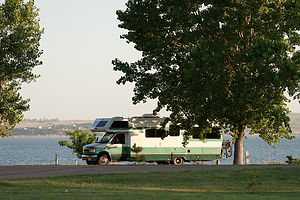 Lake McConaughy camping on bluffI had been looking forward to a few days of rest at Lake McConaughy, even before the tribulations of the previous two days. For me, the “real west” begins when the rules and regulations of the east, meant to protect its citizens from themselves, are replaced with a minimum of regulations, mostly disregarded, that give its citizens the right to have fun, or kill themselves trying, without the threat of litigation.
Lake McConaughy camping on bluffI had been looking forward to a few days of rest at Lake McConaughy, even before the tribulations of the previous two days. For me, the “real west” begins when the rules and regulations of the east, meant to protect its citizens from themselves, are replaced with a minimum of regulations, mostly disregarded, that give its citizens the right to have fun, or kill themselves trying, without the threat of litigation.
While Lake Anita in Iowa has only one small swimming beach that is closed when lifeguards are off duty, Lake McConaughy is one massively large swimming/boating/fishing/water skiing lake without any adult supervision that I could find. Its location, smack in the middle of the very dry flatlands of Nebraska and Colorado, is a natural draw to anyone looking for some water to help beat the heat and play in. It attracts a wide assortment of water craft for fishing, towing insanely oversized inflatable objects, and going fast to impress members of the opposite sex.
There are several campgrounds that offer electric hookups, and the prime sites with lake front views and access are usually reserved close to a year in advance, as part of a multi-family ritual vacation (similar to what we have done boat camping on the islands at Lake George, NY). Not to worry however, since the rest of the lake's perimeter is fair game for camping as well, for the bargain rate of $15 a night. However, this year the water levels were probably the highest I had ever seen, and many of the beaches and beach-front camping areas were now submerged in 10’ of water.
I approached the Lone Eagle Campground with trepidation since the visitor center said that while there might still be an electric site available, I would have to drive the 10 miles to the campground and check the posts to be certain. I took 2 laps around the perimeter where the electric sites were, and was surprised to see someone leaving a site directly overlooking the lake at 4:00 in the afternoon. Just to be sure, I pulled in and checked the post. No Reservation? “You got Lucky,” said the women in the next site overlooking the lake. She said the previous campers had used the site for most of the day, and then just decided to leave the premier site available to the next taker, ME!
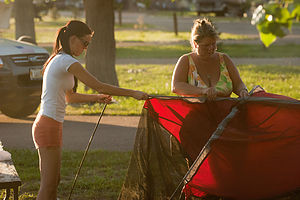 Mother & daughter tent pitching teamHer next question took me off guard. “What Exit?” I wasn’t really sure what this meant, but when she said she had lived in NJ, I remembered the Exit # bumper stickers that some people in NJ had to advertise their exit on the Garden State Parkway. I was embarrassed to say that I didn’t even really know what exit I was, so I said exit 163 hoping that there was such an exit, or if not, that she wouldn’t call me on it. She also told me that she and family friends had reserved the 3 sites on either side of me on the bluff over 6 months ago for this vacation that they take every year.
Mother & daughter tent pitching teamHer next question took me off guard. “What Exit?” I wasn’t really sure what this meant, but when she said she had lived in NJ, I remembered the Exit # bumper stickers that some people in NJ had to advertise their exit on the Garden State Parkway. I was embarrassed to say that I didn’t even really know what exit I was, so I said exit 163 hoping that there was such an exit, or if not, that she wouldn’t call me on it. She also told me that she and family friends had reserved the 3 sites on either side of me on the bluff over 6 months ago for this vacation that they take every year.
The next day was my first non-driving day and was supposed to be a “rest day”. While I started the morning with a light swim and a little beach-front reading, the back of my mind was still asking the unfortunate question, “What would Lolo do?” Traveling with Lorry is rarely just sitting around, so I left in the near mid-day sun for a 5-mile jog. Judging from the looks I got, I’m sure there are not a lot of joggers who go out in the mid-day Nebraska sun (I’m not sure I should have either).
After rehydrating and a shower, I decided to add another “activity” to the narrative of this website. Actually I could add 2 activities if I took the mountain bike down some of the trails in pursuit of a few geocaches that were supposed to be hidden around the lake.
I was about to give up on the first geocache when both the Garmin and Droid gps’s were pointing me into a forest flooded with 18” of water. I didn’t think it would be worth traipsing barefoot in the muck until I saw a plastic container floating around the theoretical position of my targeted geocache. Hmmm, plastic trash or geocache container? It turned out to be the geocache, which I signed and then relocated to higher ground to spare the next treasure seeker wet feet.
The day ended with a great sunset, and the visual of new neighbors setting up a campsite next to mine. Every member of the family, including the dreadlocked boyfriend, set up the camp with the competency that repeated practice brings. The precision mother/daughter tent pitching team was my favorite.
Description
Lake McConaughy, nicknamed "Big Mac," is the largest reservoir in Nebraska. It is located just a few miles off Interstate 80 near the Colorado border. The reservoir, which is over 20 miles long and 4 miles wide when at full capacity, was formed on the Platte River by the Kingsley Dam. The lake has over 100 mile of white-sand beaches along its shore line.
To Nebraskans, the main attraction of Lake McConaughy is water activities--swimming, boating, windsurfing, skiing, and world-class fishing. Trophy size catfish, walleye, stripers, bass, and trout have been caught in "Big Mac."
The park has 200 tent and RV sites. However, most people choose to primitive camp right on the beach at the water's edge. Camping is on a first-come first-serve basis.
Lake Anita State Park
Friday, July 15, 2011 - 4:45pm by Herb621 miles and 12 hours from our last stop - 1 night stay
Travelogue
Maybe I’m getting older, or maybe Lorry helped with the driving, but the 621 miles to Lake Anita from the Flying J felt a lot longer than they did in 2005. In fact, I wasn’t even planning on going this distance. Rather, my co-pilot at home had selected a campground at Walnut Woods State Park near Des Moines, which would have me parked by 6:00. Alas, it was not to be, since it was a Friday night, and the 21 sites at the campground were completely booked for the weekend. No matter how many times I circled the little campground loop, no sites would open up, and the campground hosts were nowhere to be found. I was getting really tired with the extra 20 miles in city rush hour traffic to get here and was hoping to crash in the daily overflow, but with the hosts missing I didn’t want to chance a late night ejection, so I headed out to drive the extra 68 miles to Lake Anita.
 Lake Anita camping on lawnNow I had a GPS to get me back the highway so it shouldn’t have been an issue. In fact I had two/three GPS’s. One was the trusty, but somewhat outdated Garmin 2610 on the dash, and the second was the Motorola Droid cell phone using Google Maps for navigation. A smaller battery powered Garmin 60CSx used for Geocaching was resting comfortably in the bureau drawer.
Lake Anita camping on lawnNow I had a GPS to get me back the highway so it shouldn’t have been an issue. In fact I had two/three GPS’s. One was the trusty, but somewhat outdated Garmin 2610 on the dash, and the second was the Motorola Droid cell phone using Google Maps for navigation. A smaller battery powered Garmin 60CSx used for Geocaching was resting comfortably in the bureau drawer.
Still, with all this satellite firepower and the fatigue of the miles, I was having a bit of difficulty finding the best way back. And the cell phone GPS was taking me down a dirt road that the Garmin 2610 didn’t even have in its database.
That’s when the final bit of untested technology proved its worth. The boys and I have recently enabled Google Latitude on our cell phones. What this does is allow Lolo (or any other trusted friend) to look at a Google Map and instantly see where in the world you are. It has a few glitches, like when it told Lolo that I was in mainland China, or Andrew in a maternity hospital in NYC, but when it works, Lolo can instantly see where all of her “men” are at any point in time across the country.
While I was driving down the dirt road, frantically in pursuit of some pavement that would get me back to Route 80, the cell phone rang. It was Lolo, asking why I was going down that little road to get to the highway. She could actually see my little smiling face avatar move down the Google Map on her computer. I was amused, impressed, and then grateful when she informed me that the next left turn should get me back to some semblance of civilization.
In another 1.5 hours and around 7:45 I arrived at Lake Anita State Park. Even at this hour it was over 90 degrees with a comparable humidity level. And of course, since it was still Friday night, every electric site was taken, so the promise of a good night’s sleep with continuous air conditioning would remain an unfulfilled fantasy.
However, there were plenty of spaces on the “no hookup” section (I wonder why?), and I quickly found a reasonably level spot to park and ponder my situation. Since there was still an hour before the “quiet time” began, I ran the generator to get some air conditioning and poured myself a tall G&T to help loosen the pains in my neck and back. The micro-wave produced some edible fare, and after a quick shower in the RV I was primed for bed.
At around 2:00 AM the sirens went off, but I had already been up for over an hour. Now I think I know why the people of the Mid-west are as God-fearing as they seem to be. The continuous lightning and thunder storm that I could see from my bedroom window was unlike anything I had ever experienced before. Heron Lake in 2002 was the closest comparable in lightning, but this included torrential rain and wind gusts that rocked the RV. Through the near continuous lightening flashes I could see my unfortunate follow campers with tents, fleeing to their cars while trying to secure the tents in the drenching rain.
At this point, I had only the sirens to contend with. I’m still not sure what the appropriate response to a siren is. As an easterner, I tried to call up Radar Now, or Weatherbug on my cell phone to get a radar visualization of the storm and any warnings, but I had no coverage. Hence, I just watched what my brethren did, and was ready to leave at a moment’s notice if someone suggested that we might be in the path of a tornado.
Finally, the storm seemed to fade away, and I was left to try and get a bit of rest before the next day’s drive to Lake McConaughy.
Description
Lake Anita State Park is located in southwest Iowa about 5 miles south of Interstate 80. The park, which contains a beautiful 171-acre artificial lake, is very popular for swimming, fishing and boating.
There is a campground with 144 sites, all within easy access of the lake.
Flying J - Toledo
Thursday, July 14, 2011 - 4:45pm by Herb560 miles and 11 hours from our last stop - 1 night stay
Travelogue
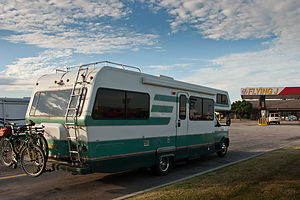 Lazy Daze camping in Flying JWhile this might be the first time that my name appears on the byline of a trip stop, this is not the first time that I have traveled solo in the RV. That dubious milestone was set this last February, when in an effort to cure a sinus infection, I migrated south for a 3-week stay in Florida. The good news was that it worked!! In a few weeks my infection was cured. The bad news was that I was traveling solo, since Lorry couldn’t leave her 90-year-old mother for such an extended duration.
Lazy Daze camping in Flying JWhile this might be the first time that my name appears on the byline of a trip stop, this is not the first time that I have traveled solo in the RV. That dubious milestone was set this last February, when in an effort to cure a sinus infection, I migrated south for a 3-week stay in Florida. The good news was that it worked!! In a few weeks my infection was cured. The bad news was that I was traveling solo, since Lorry couldn’t leave her 90-year-old mother for such an extended duration.
Despite 10 years of motor home travel across the country, I was still a little anxious about solo travel, and the extended absence from Lolo. I couldn’t do anything about the spousal separation, but before the February solo trip, I did make a few modifications to the RV which included:
- RV Cams 56-CHNV video backup camera and 5.6” monitor
- Six new Michelin LTX M/S tires and a TireTraker tire pressure monitoring system
- Viewsonic 24” HDTV and ASUS 1000he netbook PC
- Android phone for Google Maps navigation and internet connection.
Since everything had performed flawlessly on the 3000-mile solo Florida trip, I was a lot less apprehensive about this trip. I would visit some of our favorite stops on the way out west (same as our 2005 trip), and in less than 5 days be reunited with my family in Boulder, Co. It sounded like a great plan, and spirits were high as I left the driveway and pointed the Lazy Daze west once again.
 Morning coffee water with HydroplaneThe Toledo Flying J has been a regular stop for us because it’s the perfect distance from our home for a first nights stay. The 560 miles over 11 hours are not too tough on the first day of a trip when trip fatigue has not yet set in, and the excitement of starting a new adventure is high.
Morning coffee water with HydroplaneThe Toledo Flying J has been a regular stop for us because it’s the perfect distance from our home for a first nights stay. The 560 miles over 11 hours are not too tough on the first day of a trip when trip fatigue has not yet set in, and the excitement of starting a new adventure is high.
Arriving in time for cocktails I took a spot with a sunset view of the trucks leaving the fuel pumps. My only neighbor was another RV that was trailering a hydroplane boat. I think he was traveling solo too, and I felt somewhat inadequate as I have never trailered anything behind the Lazy Daze. Our 20’ Grady White boat weighs 4000# and sits on a 26’ trailer which would be a bit too much to tow. Perhaps a small car or a motorcycle trailer to carry my Honda ST1100 will be on the hitch on the next trip.
Description
Flying J's are Travel Plazas that cater to truckers and RV's. Their numerous services include gas, a dump stations, propane, fast food restaurant, limited groceries, and even showers and a barber shop. However, the best feature of all is the RV section that allows overnight parking.
They are conveniently located on most of the interstates (except for the East Coast)
Home
Sunday, August 22, 2010 - 11:00am by Lolo265 miles and 5 hours from our last stop - 1 night stay
Travelogue
Too bad the weather had put a damper on our last two days and caused us to cut our vacation a day short, because otherwise it had been a really great trip—not as dramatic and exciting as some our trips in the past, but really fun nonetheless.
Now it was time to get back to reality. Andrew had the GREs in 3 days and Tommy had to head back up to school the following weekend to lead a freshman orientation backpacking trip. After spending so much time together over the last week, I wasn’t sure whether I was looking forward to or dreading how quiet the house would be when they left. In either case, it is what it is and we would adjust once more.
Description
Our home in Upper Saddle River, a suburb of New York City.
Ausable River Campground
Saturday, August 21, 2010 - 10:45am by Lolo174 miles and 4 hours from our last stop - 1 night stay
Travelogue
We just couldn’t leave Canada without having a donut and coffee at a Tim Hortons, so right before reaching the border, we made this obligatory stop. Also, I figured it would give me a chance to get rid of the Canadian money I had left in my wallet.
The border crossing was a breeze once again, and we soon found ourselves on the familiar Adirondack Highway, pretty much a straight line home for us. However, since it was already dinner time and the rainy driving conditions weren’t great, we decided to find a place to stay for the night and then just finish up the drive in the morning.
I consulted the Woodall’s guide for a campground that wouldn’t take us too far off route. Somewhat subconsciously, I think I was also looking for something that might be fun if the weather cleared the next morning. The Ausable River Campground, just a short distance off Exit 35 seemed about right, and very near to a place I remember visiting when I was a child, Ausable Chasms.
We followed the signs for the campground and eventually pulled down a dark road past a dark deserted campground office. We weren’t sure what to do, but we certainly didn’t want to continue driving any further, so we continued driving along the road past the office into the campground itself. We noticed several empty sites in the woods along the way before coming to a more open area full of happy, partying campers. What a contrast with the deserted and quiet wooded sites we had just passed through. This was the area down by the Ausable River, and I guess it was where all the action was, rather than back in the woods. Eventually, we found the owners’ campsite and asked if we could have a site for the night. She looked in the RV, saw the boys, and suggested that we might want a site down here so the boys could socialize with the other young campers. Herb and I had to laugh, because we knew that was not even remotely on their agenda for the night. We politely declined and took a site back up in the woods towards the entrance.
Unfortunately, the next morning we woke up to more rain, and I knew that my hope of squeezing a little more vacation out of this trip was over. Oh well, it was time to head home.
Description
The Ausable River Campground is located on Route 9, just off I87 between Exits 34 and 35. It is 12 miles south of Plattsburgh, NY.
The 120-site campground is located on 130 acres along the Ausable River within the Adirondack Park. Activities include fishing, boating, and swimming on the Ausable River as well as bicycling or walking along its wilderness trails.
The most popular nearby attraction is Ausable Chasms, a 2-mile-long sandstone gorge through which the Ausable River flows. It is fed by the Rainbow Falls at its southern extreme, and eventually empties into Lake Champlain. There is a 2-mile “Rim Walk” along the edge of the rim looking down into the chasm, as well as low-key raft rides through the gorge.
The following is the website for Ausable Chasms: http://www.ausablechasm.com/assets/pdf/Welcome_map.pdf
Parc du Mont-Sainte-Anne
Thursday, August 19, 2010 - 11:00am by Lolo37 miles and 1 hour from our last stop - 1 night stay
Travelogue
 Boys running from Parc du Mont-Sainte-Anne CampgroundAfter a very satisfying lunch in Baie St. Paul we continued on to our planned destination for the night: the Parc du Mont-Sainte-Anne. We had decided to add this park to our itinerary after a father and son that we met on the Isle-aux-Coudres, who came from Mont-Sainte-Anne, told us that it had miles and miles of trails for mountain biking and running. Plus it wasn’t too far off our route to the Parc National du Mont-Tremblant where we had camping reservations for the weekend.
Boys running from Parc du Mont-Sainte-Anne CampgroundAfter a very satisfying lunch in Baie St. Paul we continued on to our planned destination for the night: the Parc du Mont-Sainte-Anne. We had decided to add this park to our itinerary after a father and son that we met on the Isle-aux-Coudres, who came from Mont-Sainte-Anne, told us that it had miles and miles of trails for mountain biking and running. Plus it wasn’t too far off our route to the Parc National du Mont-Tremblant where we had camping reservations for the weekend.
I had mentioned in the previous stop that there is a different sort of feeling that one gets when the half way, or now heading towards home, point of a trip is reached, but I think none of us felt it as hard as Andrew, who was scheduled to take the GREs a few days after our return home. It was time to really kick into gear on the studying, and I must say he really did. However, being confined together in such close quarters, we had to find a way for him to do this without driving the rest of us crazy. Going through his little box of the 500 most commonly used words on the GRE and using them on us whenever appropriate, and oftentimes when not even remotely appropriate, definitely improved our vocabulary, but began to get on our nerves. Then there were the timed practice tests where we all had to be quiet so he could concentrate. This was not going to work. Tommy was ready to choke him.
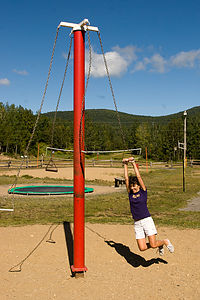 Lolo Swinging AroundWhen we got to the campground in Mont-Sainte-Anne, he was banished to a picnic table on a nearby vacant campsite, where he could take his practice tests undisturbed, and we could speak above a whisper. I was quite proud of him; this was vacation after all, and he was working awfully hard. Hopefully his efforts would pay off.
Lolo Swinging AroundWhen we got to the campground in Mont-Sainte-Anne, he was banished to a picnic table on a nearby vacant campsite, where he could take his practice tests undisturbed, and we could speak above a whisper. I was quite proud of him; this was vacation after all, and he was working awfully hard. Hopefully his efforts would pay off.
Herb and I decided to take our bikes to explore the campground and try to figure out the mountain biking trails. It was really a very nice campground with spacious, wooded, sites. A short distance from our site there was a small lake for swimming and a bit further on we came across a feature that I had never seen in a campground before—an animal farm, complete with goats and sheep. The mountain biking trails that led from the campground were a little more confusing than we had anticipated, and we weren’t sure exactly where we were going. At one point we came out of the woods onto a big playground that I could not picture being allowed to exist in the U.S. It was actually very cool. Besides trampolines, old fashioned see-saws, and a device you could hang on and swing madly around a pole, there was an entire obstacle course with fences to climb, tunnels to go through, rope bridges to cross, etc. Rather than injuring myself right way, I decided to come back later with the boys—they hate missing an opportunity to see me do something foolish.
 Parc du Mont-Sainte-Anne Llama?Part of our objective for this bike ride was to find a good trail for the boys to go on a long run, but the ones we went on were confusing and not particularly great for running. Having nothing better to report back to them, I suggested they run along the road back out to Route 360, where the map showed a trail that ran alongside the highway. While they did that, Herb and I went out for a run too and headed in the same direction that they went. However, shortly after leaving the campground, we noticed a sign for the Le circuit Jean-Larose trail that led off to the right into the woods. It traced a lovely stream through a peaceful forest for most of its 7.5 km before ending at the parking lot at the base of Mont-Sainte-Anne. I only wish I had known about this trail before the boys went out on their run. It would have been so much nicer running along this wooded stream than along a boring road. They did, however, get to run this trail early the next morning before we left for Mont-Tremblant.
Parc du Mont-Sainte-Anne Llama?Part of our objective for this bike ride was to find a good trail for the boys to go on a long run, but the ones we went on were confusing and not particularly great for running. Having nothing better to report back to them, I suggested they run along the road back out to Route 360, where the map showed a trail that ran alongside the highway. While they did that, Herb and I went out for a run too and headed in the same direction that they went. However, shortly after leaving the campground, we noticed a sign for the Le circuit Jean-Larose trail that led off to the right into the woods. It traced a lovely stream through a peaceful forest for most of its 7.5 km before ending at the parking lot at the base of Mont-Sainte-Anne. I only wish I had known about this trail before the boys went out on their run. It would have been so much nicer running along this wooded stream than along a boring road. They did, however, get to run this trail early the next morning before we left for Mont-Tremblant.
After the boys got back to the campground, and confirmed that my suggested run was indeed boring, I asked them to come with me to the “extreme” playground that I found. We went through the obstacle course together, swung around on the crazy swing, and generally had a lot of laughs, most of them at my expense.
Description
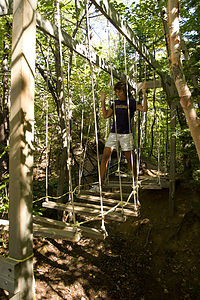 Extreme Lolo on Obstacle CourseThe Parc du Mont-Sainte-Anne is a very popular, year-round wilderness resort centered around the 2,625 foot mountain of the same name.
Extreme Lolo on Obstacle CourseThe Parc du Mont-Sainte-Anne is a very popular, year-round wilderness resort centered around the 2,625 foot mountain of the same name.
Winter activities in the park include downhill skiing, cross-country skiing, dog-sledding, snowshoeing, and snowmobiling. It was named by Ski Canada as the best spring skiing destination in the east.
In summer and fall, the mountain and its surrounding area turns into a mountain biker’s paradise, and even served as the host of the 2010 Mountain Bike and Trail World Championships. Besides the hard core trails down the mountain itself, there are miles and miles of much milder trails for all levels of expertise.
Parc du Mont-Sainte-Anne is located just 40 minutes northeast of Quebec City. To get to the park, exit off of Route 138 onto Route 360 east near the town of Ste-Anne-de-Beaupré.
There is a 166-site campground within the park, just 7 km east of the alpine ski area. The campground has a large lake for swimming, mountain bike trails, a playground, and even an animal farm.
